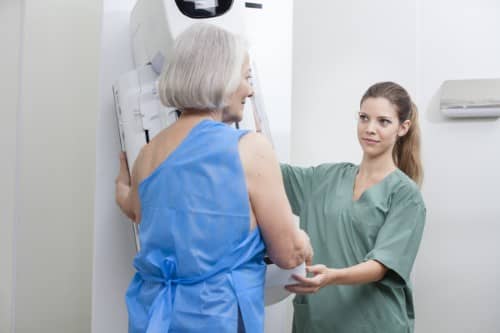If you are about to get your first mammogram, it’s normal to feel some anxiety. But you can put your mind at ease if you approach the exam armed with knowledge. Following are some tips to help you be iNFORMED.
1. Mammograms are lifesaving.
Finding breast cancer early reduces your risk of dying from the disease by 25-30% or more.I And mammograms are shown to help identify cancer early, when it may be more easily treated. However, research shows that nearly half of women still do not get regular mammograms.ii
2. Experts disagree about when to start getting mammograms, and how often.
The American College of Obstetricians and Gynecologists (ACOG), the American Cancer Society (ACS), and the U.S. Preventive Services Task Force (USPSTF) all recommend different ages for starting regular mammograms: 40, 45 and 50 respectively.The ACOG recommends women aged 20–39 years go for clinical breast examinations every 1–3 years, and for women aged 40 years and older, clinical breast examination should be performed annually.iiiAccording to the ACS, women should begin regular screening mammography at 45 years old; until age 54 they should continue with annual screenings. Then, women 55 years and older should transition to screening every other year.iii
The ACS recommends women should get screened annually from ages 45-54; women 55 and older should continue to get screened annually or transition to every other year. The ACS also notes that women should have the opportunity to begin screening at 40, with a doctor’s recommendation.iii
The USPSTF recommends women between the ages of 50 and 74 get screened every other year.iii The USPSTF asserts there is not enough evidence to assess the benefits and harms of screening mammography in women 75 years and older. iii
The bottom line is that you should discuss with your physician the schedule for mammograms that is right for you.
3. Ask if your health care facility offers mammograms with CAD.
Computer-aided detection (CAD) can help radiologists find areas of concern in a mammogram that may need further testing. It acts as a second pair of eyes for radiologists and can help reduce the rate of false negative results. An extensive body of literature strongly supports the use of CAD in the detection of breast cancer, especially in its earlier stages when it is often more easily treated.iv ,v ,vi ,vii
4. Know your breast density.
An estimated 40% of women have dense breast tissue that can mask the presence of cancerous tissue in standard mammography.viii As breast density increases, mammography sensitivity decreases. Currently, 26 states have passed breast density notification legislation that requires women to be informed of their breast density and whether they might benefit from additional screening. New technology is able to help radiologists more accurately and consistently determine breast density.
5. 3D mammography may be more effective than 2D mammography
A recent study found the addition of tomosynthesis – also known as 3D mammograms – to digital mammography increased the cancer detection rate for both women with dense and non-dense breasts.ix With a traditional 2D mammogram radiologists only capture two images per breast. But tomosynthesis produces multiple images, or slices, of each breast taken from different angles, which can help radiologists better identify suspicious lesions.
6. Avoid wearing deodorant or antiperspirant during a mammography.
Deodorant and antiperspirant can show up on mammography film and interfere with test results. Powder, lotion and other ointments can also appear as white spots, which could be mistaken for cancer.
7. Additional screening does not necessarily mean you have breast cancer.
According to the American Cancer Society, about 1 in 10 women who have a mammogram will require more tests.xHowever, only 8 to 10 percent of those women will need a biopsy and about 80 percent of these biopsies will turn out NOT to be cancer.xi
8. Bring your past mammogram images/results with you.
After you receive your results, file them away in a safe place so you can bring them to your next mammogram.
9. Don’t be afraid.
Typically, a mammography will only take about 20 minutes. 3D mammograms can take a few seconds longer because it captures more images.xii Most women experience only slight discomfort during the exam and the procedure is safe – there’s only a very tiny amount of radiation exposure involved. To relieve the anxiety of waiting for results, try to go to a center that will give you results quickly – usually before you leave the office. Also, remember that only two to four screening mammograms in 1,000 lead to a diagnosis of breast cancer.xiii
10. Remember to schedule your appointment for next year.
And don’t forget to remind your family and friends to book their next appointments, too.
About iCAD:
iCAD is a global medical technology leader providing innovative cancer detection and therapy solutions. We work passionately to provide precise, powerful healthcare solutions expertly engineered to optimize operational efficiency, clinician confidence and patient outcomes. iCAD offers a comprehensive range of artificial intelligence and workflow solutions to support rapid and accurate detection of breast and colorectal cancers. For more information, visit www.icadmed.com or www.xoftinc.com.
References:
i BreastCancer.org. Updated 2/4/16. http://www.breastcancer.org/symptoms/testing/types/ mammograms/benefits_risks
ii M Subar, SA Lust, and W Lin. Cancer Res. December 15, 2010:70:S4-7.
iii http://emedicine.medscape.com/article/2247407-overview
iv Fenton JJ, Xing G, Elmore JG, Bang H, Chen SL, Lindfors KK, et al. Short-Term Outcomes of Screening Mammography Using Computer-Aided Detection: A Population-Based Study of Medicare Enrollees. Ann Intern Med. 2013;158:580-587.
v Gilbert FJ, Astley SM, Gillian MG, et al; CADET II Group, Single reading with computer-aided detection for screening mammography. N Engl J Med. 2008;359(16):1675-1684.
vi Bargalló, Xavier et al., Single reading with computer-aided detection performed by selected radiologists in a breast cancer screening program. European Journal of Radiology 2014:83(11): 2019-2023
vii Gromet M, Comparison of Computer-Aided Detection to Double Reading of Screening Mammograms: Review of 231,221 Mammograms. American Journal of Roentgenology 2008:190(4):854-859
viii http://www.areyoudense.org/
ix http://jama.jamanetwork.com/article.aspx?articleid=2516698&resultClick=3
x American Cancer Society. Updated 4/25/16. http://www.cancer.org/treatment/understandingyourdiagnosis/examsandtestdescriptions/ mammogramsandotherbreastimagingprocedures/mammograms-and-other-breast-imaging-procedures-called-back-after-mammogram xihttp://www.completewomensimaging.com/joomla/images/pdfFiles/Mammographyneed2know.pdf
xii http://www.stopcancerfund.org/p-breast-cancer/is-digital-mammography-better/
